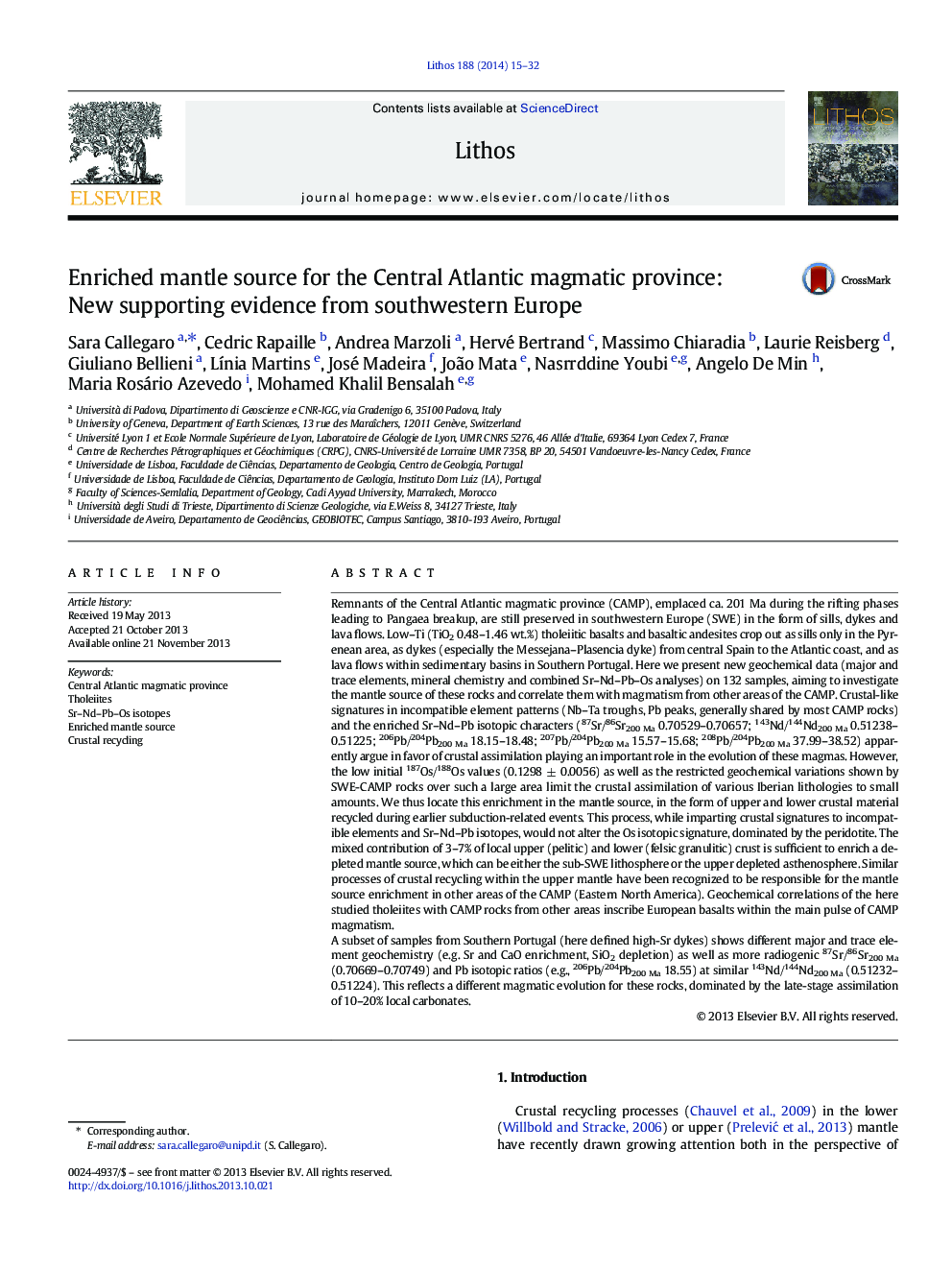| کد مقاله | کد نشریه | سال انتشار | مقاله انگلیسی | نسخه تمام متن |
|---|---|---|---|---|
| 4716085 | 1638682 | 2014 | 18 صفحه PDF | دانلود رایگان |
• CAMP tholeiitic sills, dykes and lava flows in Southwestern Europe
• Enriched Sr–Nd–Pb signatures, low radiogenic 187Os/188Os
• Lower and upper crustal recycling within the upper mantle
• SWE magmatism inscribed within the main pulse of CAMP activity
Remnants of the Central Atlantic magmatic province (CAMP), emplaced ca. 201 Ma during the rifting phases leading to Pangaea breakup, are still preserved in southwestern Europe (SWE) in the form of sills, dykes and lava flows. Low–Ti (TiO2 0.48–1.46 wt.%) tholeiitic basalts and basaltic andesites crop out as sills only in the Pyrenean area, as dykes (especially the Messejana–Plasencia dyke) from central Spain to the Atlantic coast, and as lava flows within sedimentary basins in Southern Portugal. Here we present new geochemical data (major and trace elements, mineral chemistry and combined Sr–Nd–Pb–Os analyses) on 132 samples, aiming to investigate the mantle source of these rocks and correlate them with magmatism from other areas of the CAMP. Crustal-like signatures in incompatible element patterns (Nb–Ta troughs, Pb peaks, generally shared by most CAMP rocks) and the enriched Sr–Nd–Pb isotopic characters (87Sr/86Sr200 Ma 0.70529–0.70657; 143Nd/144Nd200 Ma 0.51238–0.51225; 206Pb/204Pb200 Ma 18.15–18.48; 207Pb/204Pb200 Ma 15.57–15.68; 208Pb/204Pb200 Ma 37.99–38.52) apparently argue in favor of crustal assimilation playing an important role in the evolution of these magmas. However, the low initial 187Os/188Os values (0.1298 ± 0.0056) as well as the restricted geochemical variations shown by SWE-CAMP rocks over such a large area limit the crustal assimilation of various Iberian lithologies to small amounts. We thus locate this enrichment in the mantle source, in the form of upper and lower crustal material recycled during earlier subduction-related events. This process, while imparting crustal signatures to incompatible elements and Sr–Nd–Pb isotopes, would not alter the Os isotopic signature, dominated by the peridotite. The mixed contribution of 3–7% of local upper (pelitic) and lower (felsic granulitic) crust is sufficient to enrich a depleted mantle source, which can be either the sub-SWE lithosphere or the upper depleted asthenosphere. Similar processes of crustal recycling within the upper mantle have been recognized to be responsible for the mantle source enrichment in other areas of the CAMP (Eastern North America). Geochemical correlations of the here studied tholeiites with CAMP rocks from other areas inscribe European basalts within the main pulse of CAMP magmatism.A subset of samples from Southern Portugal (here defined high-Sr dykes) shows different major and trace element geochemistry (e.g. Sr and CaO enrichment, SiO2 depletion) as well as more radiogenic 87Sr/86Sr200 Ma (0.70669–0.70749) and Pb isotopic ratios (e.g., 206Pb/204Pb200 Ma 18.55) at similar 143Nd/144Nd200 Ma (0.51232–0.51224). This reflects a different magmatic evolution for these rocks, dominated by the late-stage assimilation of 10–20% local carbonates.
Journal: Lithos - Volume 188, 1 February 2014, Pages 15–32
